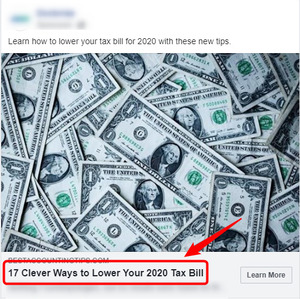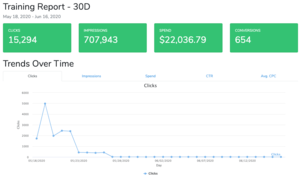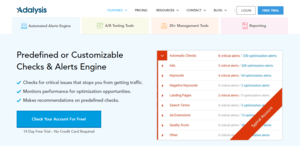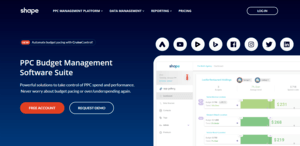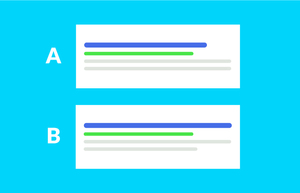CBD and hemp products are one of the fastest-growing trends in the market today. Thanks to the recent law changes, the CBD market is expected to reach $16.32 Billion by 2026 (GlobeNewsWire).
One in seven Americans personally use cannabidiol based products, that’s 14% of the US population (Gallup) that use CBD-derived products.

There’s a huge first-mover advantage for CBD companies looking to dominate the market. The competition is at its lowest, and people are eager to learn about these new substances.
By seizing a good market share at such an early stage, you’ll guarantee your brand’s success for years to come when you advertise and consistently build content and serve your audiences.
So, that makes you wonder:
What’s the best way to advertise CBD/hemp products online?
A Brief CBD Introduction…
CBD or cannabidiol is an ingredient of cannabis. However, legal CBD is not psychoactive, and not part of any of these groups: stimulants, depressants, opioids, and hallucinogens. Psychoactive drugs affect the body’s central nervous system and are different from legal CBD.
THC (tetrahydrocannabinol), an ingredient of cannabis, affects the classic symptoms of feeling “high”.
However, Hemp-derived CBD contains a maximum of 0.3% THC and is the legal limit for selling CBD products. The passage of the Farm Bill in 2018 made it legal in the US to sell hemp and hemp-derived products. Still, there are certain restrictions, and also state-by-state.
Many people find CBD to help with (although not scientifically proven):
- Pain relief
- Inflammation reduction
- Anxiety & depression relief
- Easing or reducing migraines
- Treat or alleviate certain skin conditions
- Other benefits, acting as an antioxidant, for example
There are many CBD products available, with product types like:
- CBD tinctures (drops)
- Edibles (chocolate infused, coffee, etc.)
- Creams, skin salves (help with inflammation or arthritis)
- Capsules (tablet form)
- Isolates (powder form)
- Vaporizers (“vaping” products)
- CBD for pets (a specialized niche within the CBD niche)
Additionally, there are nasal sprays, candy, gummies, and candles that further reveal the variety of ideas within the popular CBD niche.
When advertising on any ad platform, and especially using Facebook & Google, do NOT try to circumvent the systems or go against their policies. As a matter of fact, this is a wise rule to follow overall… and certainly when targeting the CBD market.
1 – Facebook, Instagram, Google Ads (Search & Display)

Facebook and Google are two of the biggest advertising platforms today. They allow you to display your paid ads to a large customer base to boost sales and grow a successful business.
However:
These platforms are super suspicious around cannabis and hemp-derived products. Many advertisers are facing challenges when trying to run ads on Facebook and Google. Hemp (topicals) are ok at this time, but stay on top of the advertising guidelines for Facebook and read the ad policies for Google. You can’t make any medical claims about its benefits, or that your CBD products can cure or prevent serious illnesses.
Do:
 Check local state laws before selling
Check local state laws before selling
 Source tested and high-quality CBD for your products
Source tested and high-quality CBD for your products
 Label your products clearly and provide certification
Label your products clearly and provide certification
 Understand how CBD works and carry out in-depth research
Understand how CBD works and carry out in-depth research
 Build a trustworthy brand for your CBD business (See certified supplier companies)
Build a trustworthy brand for your CBD business (See certified supplier companies)
Don’t:
 Sell CBD that contains more than 0.3% THC
Sell CBD that contains more than 0.3% THC
 Make medical health claims about your products
Make medical health claims about your products
 Use an unreliable or unofficial CBD supplier
Use an unreliable or unofficial CBD supplier
 Be careless when choosing a payment processor or a website builder
Be careless when choosing a payment processor or a website builder
 Take risks that could affect your business or your customers
Take risks that could affect your business or your customers
Connect and partner with industry leaders, like the National Hemp Association.
There is a lot to consider when setting up a CBD business and advertising, but thankfully…
We have found successful ways to overcome these restrictions. You can be creative too and find unique ways to advertise on these programs without violating ad platform policies.
Here’s a shortlist of great ways to advertise on Facebook & Google (search) while staying compliant.
(We’re using an example on topic “pain relief”, but you can (and should) try multiple wellness/health angles):
- Run multiple ads for topicals – like “hemp” (not CBD). Mention things like “try our new survey.” And for the pain relief angle – present a special offer/coupon that can “soothe your discomfort.”
- Send clicks to website content with an authoritative voice around “pain relief.” Capture their email and send educational materials, information, blending in offers as appropriate. You should be building your email list at all times, naturally.
- Run ads to a survey page (https://www.research.net/) – with a health/wellness focus. Implement logic to direct offers (discount codes they can use) based on their answers. The resulting page provides a button/link to your website and shopping cart. Keep it closely tied to “hemp-derived” wellness products (capsules, gummies, tinctures, pain cream, pet joint support, etc.) *See example of survey questions below.
- Capture their email for your email list (remember: no spam, build your brand, and become a trusted authority). You can now create offers that are directly tied to your CBD products from email broadcasts.
- For a wellness/pain relief survey, here are questions you might ask:
- During the past two weeks, how often have you had sleeping problems, or not waking up refreshed? (yes-often, yes-but not often, not bothered by it, I sleep great)
- In a typical week, how often do you feel anxious or stressed at work/home? (always, most of the time, about half the time, once in a while, never)
- How much would it increase the quality of your life if you slept better and/or had less stress? (a great deal, a lot, moderately, a little, none at all)
- For Facebook, create a business page as usual. Keep content minimal and within guidelines. It’s for advertising only. You are not using this page to grow organically.
- Use retargeting strategies with AI-driven ad platforms like Adroll.com (yes, you can run CBD offers directly, but your site must be pre-approved and on a case-by-case basis)
- Check policies for retargeting on other platforms like Yahoo Gemini & Taboola.
- Reach out to targeted content advertisers like Leafly, HighTimes and market-specific journals. Do your research and allocate budgets accordingly. Sponsored content can work well.
- Remember to track the statistics and measure against your KPI’s. Tag all links so they can be easily tracked and reported on inside your analytics. Continue testing and tweaking.
Additional and useful CBD marketing ideas for scaling:
- Provide e-guides as friendly bribes to capture emails (no spamming).
- Consider programmatic advertising on 3rd party platforms, like Vana and Fieldtest.
- Influencer marketing opportunities: reach out to influencers that are related to your products and offer them a starting package.
- Podcasting is more popular than ever. Review podcasts for your market and reach out to the owners with an opportunity for links and shout-outs.
These tactics work well at the time of writing. We use several other strategies that are built on a long-term, growth & brand building focus. (See below for links to sign up)
REMINDER:
Stay updated with your national & local CBD laws and avoid doing business in states where cannabis is still illegal. If you are selling CBD products locally via a dispensary, make sure to follow guidelines and watch for any changes in your market.
TIP: To get more quality traffic for your dispensary and cannabis operations, all while staying compliant, visit The SM Services.
Also:
You must be sure not to include banned terms like “cannabis,” “CBD,” or other related keywords in your landing page and ad copy. Don’t use emojis with “bee” in words (c-bee-d) either!
2 – Third-Party Ads

Third-party ads can be a great way to grow your business online. That’s even more true if you’re going to focus your marketing on native advertising.
Native ads are a type of online ads that match the appearance, function, and form of the content on the page. This kind of advertising doesn’t interrupt the user experience. So, that makes viewers more likely to notice your message and interact with it.
Unfortunately, there are still some ad networks that do not accept CBD/Hemp related products.
But…
Your options here are limitless.
Many third-party ad programs are aware of the benefits of CBD-derived products and allow their advertisement.
So:
You can reach millions of users on different websites and grow awareness around your brand. Better yet, you’ll have fewer regulations and restrictions to deal with.
3 – SEO (Search Engine Optimization)
SEO is a strategy based on creating content and optimizing it via keywords and links to rank high on Google’s first page. When people search on Google for related terms such as “CBD” or “cannabidiol,” your site can appear at the top.
These users will then visit your pages and get their questions answered, which helps promote your brand as a leading authority in the industry.
You can then convert those visitors into loyal clients via smart sales funnels and e-commerce shopping systems like:
Another way to go about this is to focus on smaller markets with local SEO. You’ll target local consumers where cannabis-related products are legal and can be purchased. Include local ranking signals for Google to show up high in the local map pack.
4 – Email Marketing

Email marketing is a winning marketing strategy for CBD companies for one reason:
It gives them full autonomy.
Building a list of email subscribers allows you to reach out to your audience whenever you want. You can keep them updated with your latest brand announcements and products for no cost.
However…
The restrictions this time are enforced by your subscribers. Email marketing is a pure value-first marketing strategy, and your prospects can smell when they’re being used.
You have to familiarize your prospects with your brand by sharing helpful content. And you must prove your expertise if you want to keep your audience interested in your offers.
Wrapping It Up
Most advertising platforms are still testing the waters when it comes to CBD and hemp. But, there are lots of ways you can bring attention to your products without violating any policies.
Looking for an efficient strategy to grow your CBD business faster?
Chaosmap offers professional CBD and hemp-products website development, advertising & marketing services. We provide expert advice and consulting on how to turn your company into a profitable business, including scaling an existing, proven business.
Check out our digital marketing services and contact us to learn more about how we can help you propel your CBD, health & wellness business forward, faster.
P.S.
Here’s more information on CBD/Hemp e-comm websites we can build for you.











